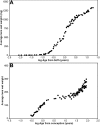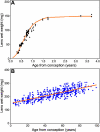Growth of the human eye lens
Abstract
Purpose: To analyze human lens growth from the accumulation of wet weight as a function of age.
Methods: Wet weights were assembled for over 1,100 human lenses, ranging in age from 6 months prenatal to 99 years postnatal, and were examined using various growth models. Initially, prenatal and postnatal data were examined separately, to determine the growth modes and then all data were fitted to a single equation.
Results: Variations in weights due to tissue handling procedures and the unavailability of statistical data for averaged sets precluded the use of >500 values in the present analysis. Regression of age on log lens weight for the remaining 614 lenses indicated that, unlike other species, human lens growth appears to take place in two distinct phases. It was found that asymptotic growth during prenatal life and early childhood generates about 149 mg of tissue in a process, which can be modelled with a Gompertz function. Soon after birth, growth becomes linear, dropping to 1.38 mg/year, and this rate is maintained throughout the rest of life. The relationship of lens wet weight with age over the whole of the lifespan could best be described with the expression, W=1.38A(b) + 149exp;[exp;(1.6-3A(c))], where W is lens weight in mg, A(b) is postnatal age in years and A(c) is the time since conception in years. Comparison of 138 male and 64 female lenses indicated that there was no statistically significant difference between male and female lens weights in the linear (adult) growth mode.
Conclusions: Human lens growth differs from growth in other species in that it occurs in two distinct modes. The first follows a sigmoidal relationship and provides an initial burst of rapid growth during prenatal development with an apparent termination at or shortly after birth. The second growth mode is linear, adding 1.38 mg/year to lens wet weight, throughout life. Because of the variability in available lens wet weight data, further studies, preferably using lens dry weights or protein contents, will be required to establish precisely when the transition from one growth mode to the other occurs. In contrast to previous reports, it was concluded that, like other species, there are no gender differences in human lens weights.
Figures





References
-
- Augusteyn RC, Rosen AM, Borja D, Ziebarth NM, Parel JM. Biometry of primate lenses during immersion in preservation media. Mol Vis. 2006;12:740–7. http://www.molvis.org/molvis/v12/a83/ - PubMed
-
- Lovicu FJ, McAvoy JW. Growth factor regulation of lens development. Dev Biol. 2005;280:1–14. - PubMed
-
- Kuszak JR, Zoltoski RK, Sivertson C. Fibre cell organization in crystalline lenses. Exp Eye Res. 2004;78:673–87. - PubMed
-
- Pierscionek BK, Augusteyn RC. Species variations in optical parameters of the eye lens. Clin Exp Optom. 1993;76:22–6.
-
- Augusteyn RC, Coulson GM, Landman KA. Determining kangaroo age from lens protein content. Aust J Zool. 2003;51:485–94.
Publication types
MeSH terms
Grants and funding
LinkOut - more resources
Full Text Sources
Medical
